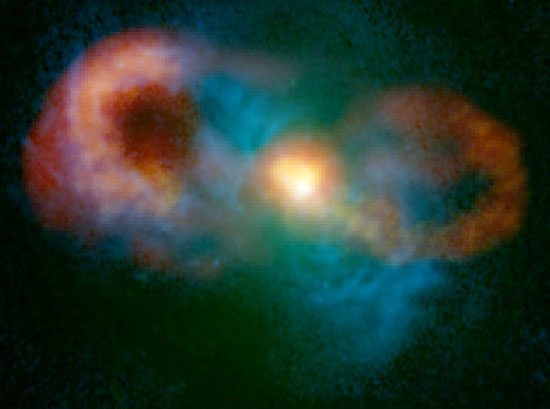New observations of the Teacup Galaxy show that even black holes with wimpy radio jets can quench a galaxy's star formation.

C. Harrison / A. Thomson / B. Saxton / NRAO / AUI / NSF / NASA
An unassuming nearby galaxy nicknamed The Teacup (more formally known as J1430+1339) hides a tempest inside. The supermassive black hole at this galaxy's center is chowing down furiously on gas — seen from another angle, the accretion disk would outshine the entire host galaxy. But a layer of dust obscures the action.
The jets the black hole spits out as it feeds are relatively weak, giving the quasar the classification of "radio-quiet." Yet despite the obscuring dust and the weak jets, astronomers see in this image the surprisingly strong effect the stunted jets have on the host galaxy.
The yellow blobs at the center of the image show where the jet's charged particles, which shoot out at near the speed of light, are slamming into surrounding gas. They have already inflated bubbles that extend between 33,000 and 39,000 light-years to the east and west of the galaxy's nucleus.
That feeding black holes spit energy back out into their galactic environment is hardly new. "The surprise here was the way the black hole was performing the feedback," says Chris Harrison (Durham University, UK), who led the study.
Radio-quiet galaxies were previously thought to have jets too wimpy to affect the host galaxy. Instead, astronomers thought the black hole might transmit energy into its surroundings via a wind that flows off its accretion disk. It's possible there's a strong disk wind in this galaxy too. But these observations, part of a larger sample of dust-obscured, radio-quiet quasars, show that even wimpy jets can still have a tremendous effect on star formation and galaxy evolution.
 0
0
Comments
You must be logged in to post a comment.